Holmes Institute T2 2019 HA3042 Taxation Law Individual Assignment
VerifiedAdded on 2022/11/01
|9
|2781
|62
Homework Assignment
AI Summary
This assignment analyzes various aspects of Australian taxation law, focusing on capital gains and depreciation. It examines scenarios involving Jasmine, an Australian resident, and her capital assets, including a house, car, business goodwill, and furniture, assessing their tax implications based on the Income Tax Assessment Act (ITA Act) of 1936 and 1997. The solution details the tax treatment of assets purchased before and after specific dates, personal use assets, business assets, and collectibles. Furthermore, the assignment explores depreciation, discussing depreciating assets, simplified depreciation for small businesses, and the calculation of depreciation using methods such as the diminishing value and prime cost methods, with a case study involving John and a CNC machine. The assignment refers to relevant tax rulings and provisions to provide a comprehensive understanding of the tax implications.
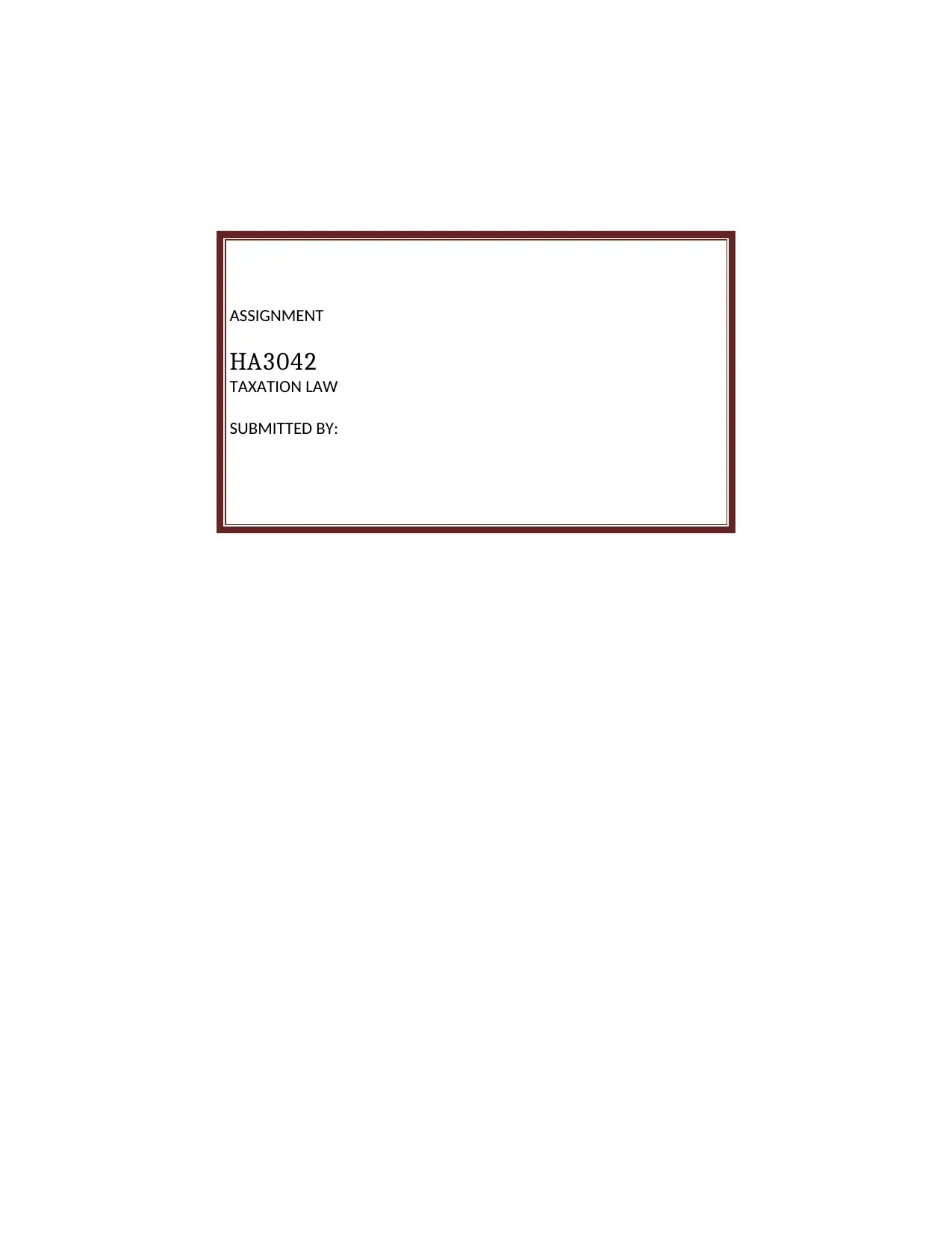
ASSIGNMENT
HA3042
TAXATION LAW
SUBMITTED BY:
HA3042
TAXATION LAW
SUBMITTED BY:
Paraphrase This Document
Need a fresh take? Get an instant paraphrase of this document with our AI Paraphraser
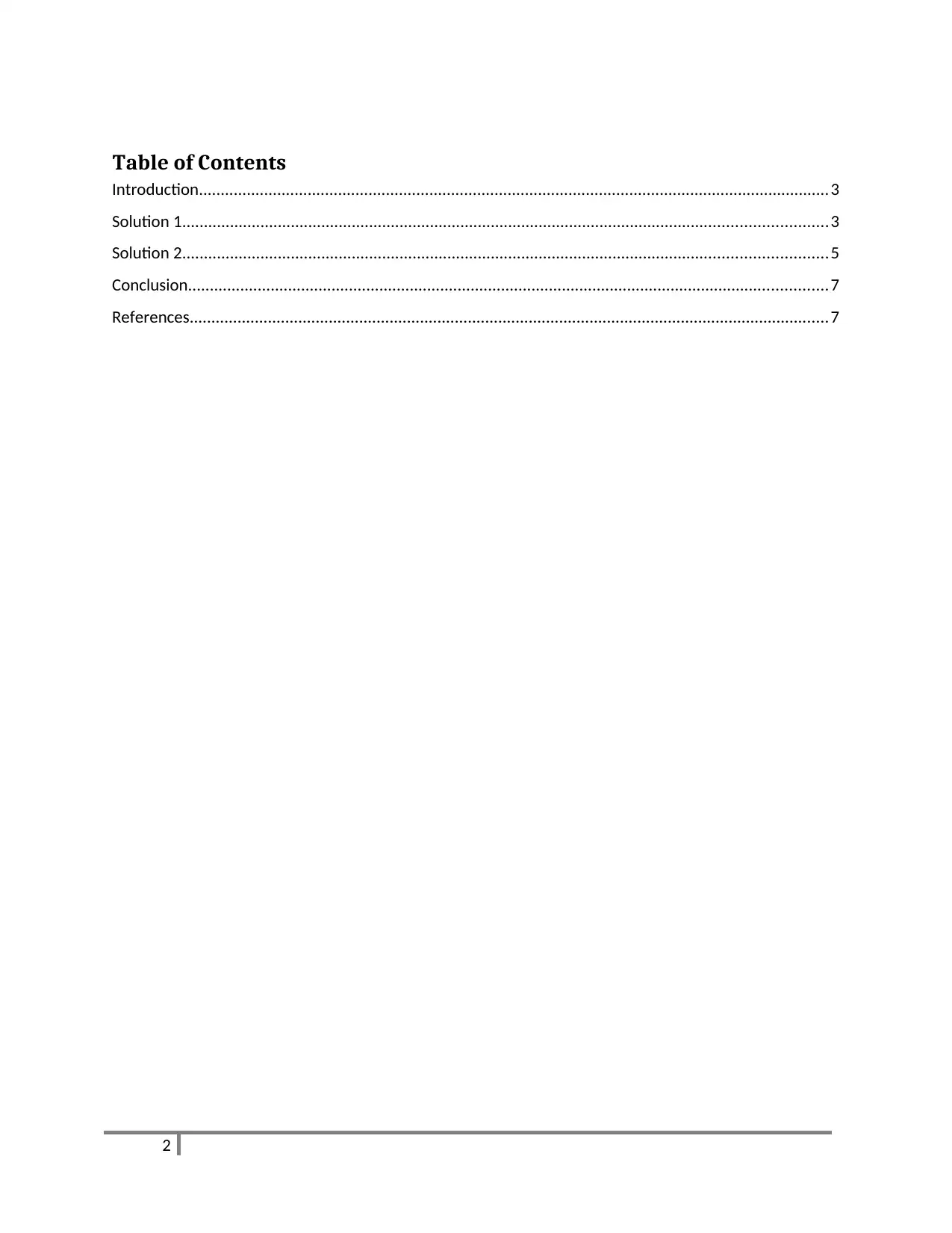
Table of Contents
Introduction.................................................................................................................................................3
Solution 1....................................................................................................................................................3
Solution 2....................................................................................................................................................5
Conclusion...................................................................................................................................................7
References...................................................................................................................................................7
2
Introduction.................................................................................................................................................3
Solution 1....................................................................................................................................................3
Solution 2....................................................................................................................................................5
Conclusion...................................................................................................................................................7
References...................................................................................................................................................7
2
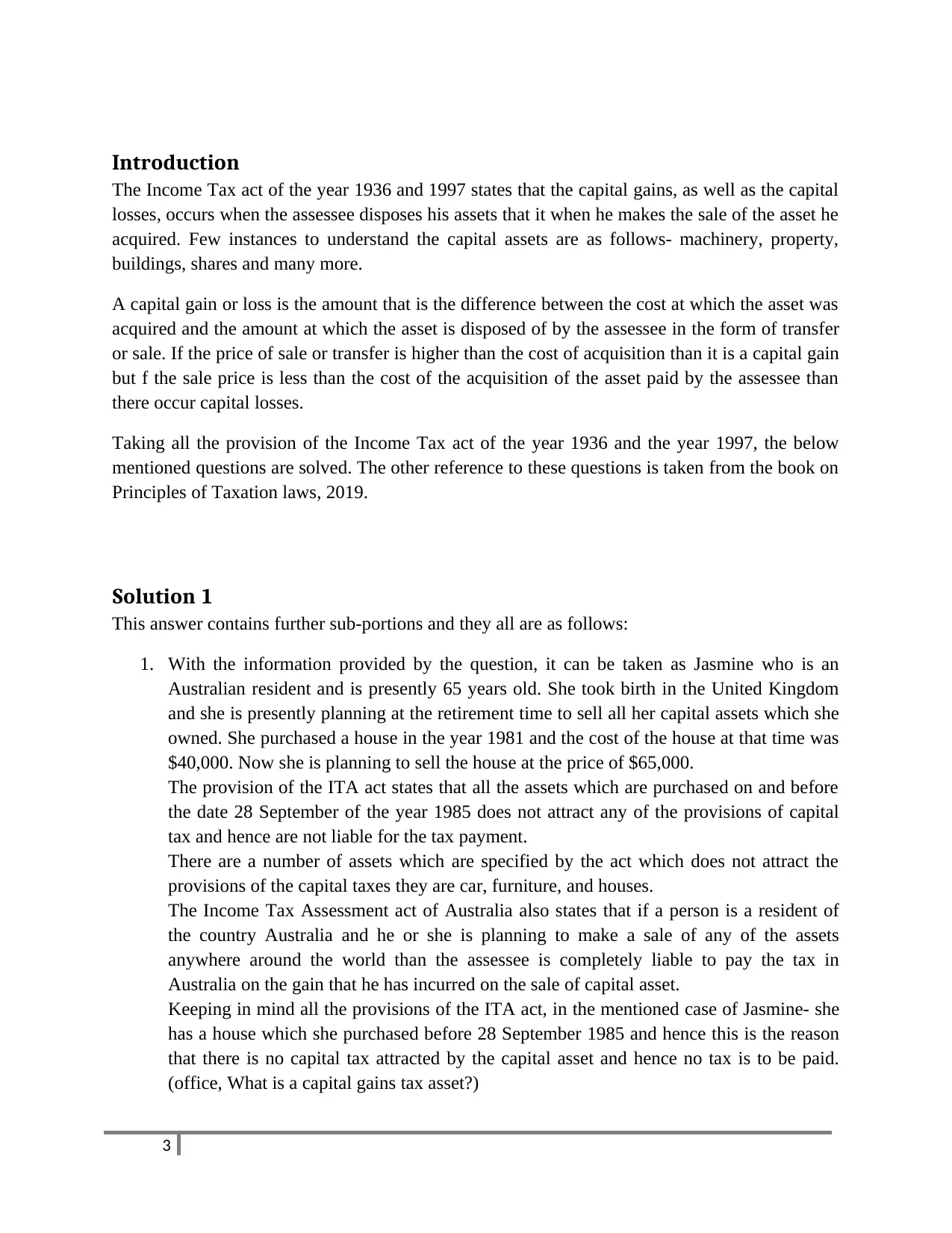
Introduction
The Income Tax act of the year 1936 and 1997 states that the capital gains, as well as the capital
losses, occurs when the assessee disposes his assets that it when he makes the sale of the asset he
acquired. Few instances to understand the capital assets are as follows- machinery, property,
buildings, shares and many more.
A capital gain or loss is the amount that is the difference between the cost at which the asset was
acquired and the amount at which the asset is disposed of by the assessee in the form of transfer
or sale. If the price of sale or transfer is higher than the cost of acquisition than it is a capital gain
but f the sale price is less than the cost of the acquisition of the asset paid by the assessee than
there occur capital losses.
Taking all the provision of the Income Tax act of the year 1936 and the year 1997, the below
mentioned questions are solved. The other reference to these questions is taken from the book on
Principles of Taxation laws, 2019.
Solution 1
This answer contains further sub-portions and they all are as follows:
1. With the information provided by the question, it can be taken as Jasmine who is an
Australian resident and is presently 65 years old. She took birth in the United Kingdom
and she is presently planning at the retirement time to sell all her capital assets which she
owned. She purchased a house in the year 1981 and the cost of the house at that time was
$40,000. Now she is planning to sell the house at the price of $65,000.
The provision of the ITA act states that all the assets which are purchased on and before
the date 28 September of the year 1985 does not attract any of the provisions of capital
tax and hence are not liable for the tax payment.
There are a number of assets which are specified by the act which does not attract the
provisions of the capital taxes they are car, furniture, and houses.
The Income Tax Assessment act of Australia also states that if a person is a resident of
the country Australia and he or she is planning to make a sale of any of the assets
anywhere around the world than the assessee is completely liable to pay the tax in
Australia on the gain that he has incurred on the sale of capital asset.
Keeping in mind all the provisions of the ITA act, in the mentioned case of Jasmine- she
has a house which she purchased before 28 September 1985 and hence this is the reason
that there is no capital tax attracted by the capital asset and hence no tax is to be paid.
(office, What is a capital gains tax asset?)
3
The Income Tax act of the year 1936 and 1997 states that the capital gains, as well as the capital
losses, occurs when the assessee disposes his assets that it when he makes the sale of the asset he
acquired. Few instances to understand the capital assets are as follows- machinery, property,
buildings, shares and many more.
A capital gain or loss is the amount that is the difference between the cost at which the asset was
acquired and the amount at which the asset is disposed of by the assessee in the form of transfer
or sale. If the price of sale or transfer is higher than the cost of acquisition than it is a capital gain
but f the sale price is less than the cost of the acquisition of the asset paid by the assessee than
there occur capital losses.
Taking all the provision of the Income Tax act of the year 1936 and the year 1997, the below
mentioned questions are solved. The other reference to these questions is taken from the book on
Principles of Taxation laws, 2019.
Solution 1
This answer contains further sub-portions and they all are as follows:
1. With the information provided by the question, it can be taken as Jasmine who is an
Australian resident and is presently 65 years old. She took birth in the United Kingdom
and she is presently planning at the retirement time to sell all her capital assets which she
owned. She purchased a house in the year 1981 and the cost of the house at that time was
$40,000. Now she is planning to sell the house at the price of $65,000.
The provision of the ITA act states that all the assets which are purchased on and before
the date 28 September of the year 1985 does not attract any of the provisions of capital
tax and hence are not liable for the tax payment.
There are a number of assets which are specified by the act which does not attract the
provisions of the capital taxes they are car, furniture, and houses.
The Income Tax Assessment act of Australia also states that if a person is a resident of
the country Australia and he or she is planning to make a sale of any of the assets
anywhere around the world than the assessee is completely liable to pay the tax in
Australia on the gain that he has incurred on the sale of capital asset.
Keeping in mind all the provisions of the ITA act, in the mentioned case of Jasmine- she
has a house which she purchased before 28 September 1985 and hence this is the reason
that there is no capital tax attracted by the capital asset and hence no tax is to be paid.
(office, What is a capital gains tax asset?)
3
⊘ This is a preview!⊘
Do you want full access?
Subscribe today to unlock all pages.

Trusted by 1+ million students worldwide
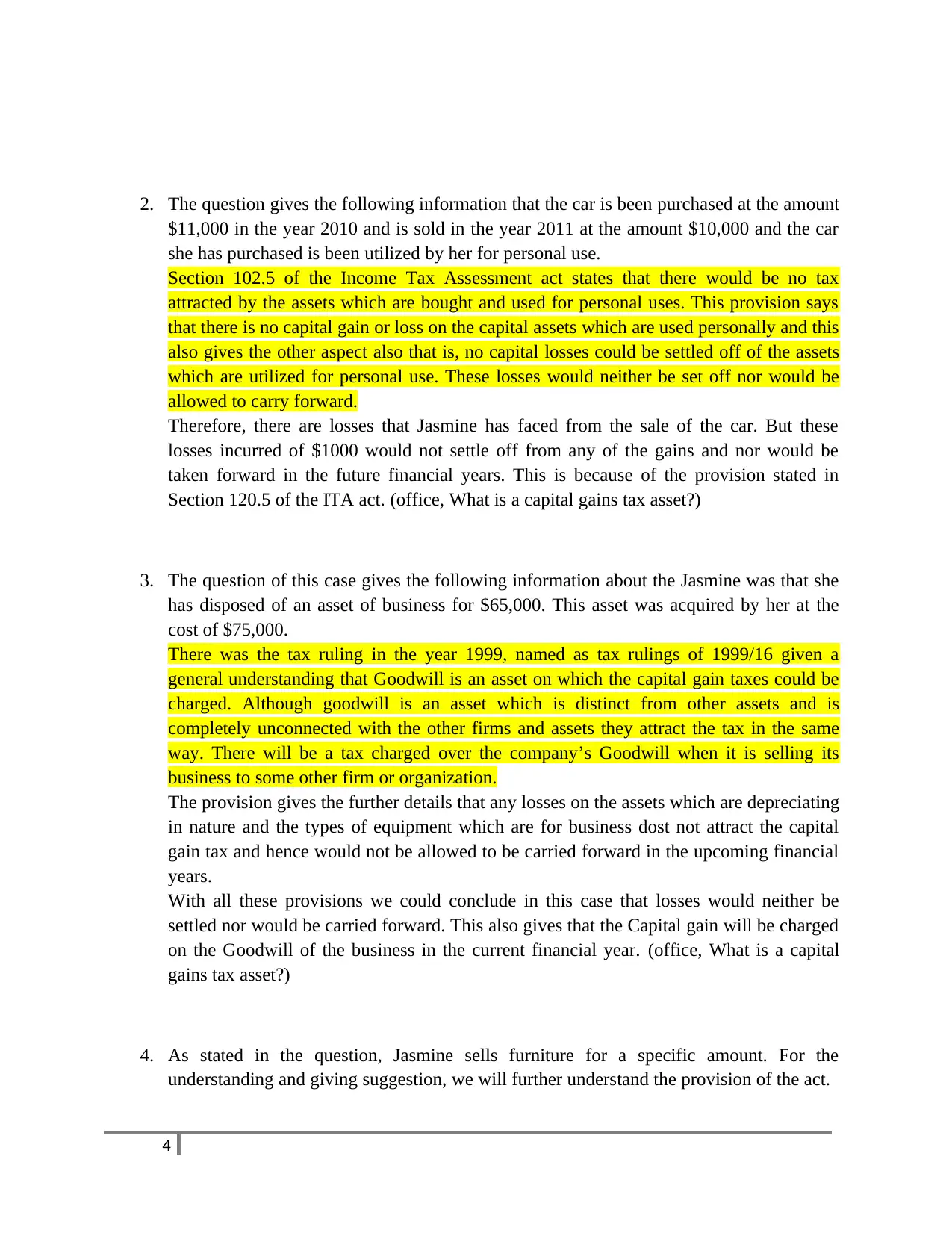
2. The question gives the following information that the car is been purchased at the amount
$11,000 in the year 2010 and is sold in the year 2011 at the amount $10,000 and the car
she has purchased is been utilized by her for personal use.
Section 102.5 of the Income Tax Assessment act states that there would be no tax
attracted by the assets which are bought and used for personal uses. This provision says
that there is no capital gain or loss on the capital assets which are used personally and this
also gives the other aspect also that is, no capital losses could be settled off of the assets
which are utilized for personal use. These losses would neither be set off nor would be
allowed to carry forward.
Therefore, there are losses that Jasmine has faced from the sale of the car. But these
losses incurred of $1000 would not settle off from any of the gains and nor would be
taken forward in the future financial years. This is because of the provision stated in
Section 120.5 of the ITA act. (office, What is a capital gains tax asset?)
3. The question of this case gives the following information about the Jasmine was that she
has disposed of an asset of business for $65,000. This asset was acquired by her at the
cost of $75,000.
There was the tax ruling in the year 1999, named as tax rulings of 1999/16 given a
general understanding that Goodwill is an asset on which the capital gain taxes could be
charged. Although goodwill is an asset which is distinct from other assets and is
completely unconnected with the other firms and assets they attract the tax in the same
way. There will be a tax charged over the company’s Goodwill when it is selling its
business to some other firm or organization.
The provision gives the further details that any losses on the assets which are depreciating
in nature and the types of equipment which are for business dost not attract the capital
gain tax and hence would not be allowed to be carried forward in the upcoming financial
years.
With all these provisions we could conclude in this case that losses would neither be
settled nor would be carried forward. This also gives that the Capital gain will be charged
on the Goodwill of the business in the current financial year. (office, What is a capital
gains tax asset?)
4. As stated in the question, Jasmine sells furniture for a specific amount. For the
understanding and giving suggestion, we will further understand the provision of the act.
4
$11,000 in the year 2010 and is sold in the year 2011 at the amount $10,000 and the car
she has purchased is been utilized by her for personal use.
Section 102.5 of the Income Tax Assessment act states that there would be no tax
attracted by the assets which are bought and used for personal uses. This provision says
that there is no capital gain or loss on the capital assets which are used personally and this
also gives the other aspect also that is, no capital losses could be settled off of the assets
which are utilized for personal use. These losses would neither be set off nor would be
allowed to carry forward.
Therefore, there are losses that Jasmine has faced from the sale of the car. But these
losses incurred of $1000 would not settle off from any of the gains and nor would be
taken forward in the future financial years. This is because of the provision stated in
Section 120.5 of the ITA act. (office, What is a capital gains tax asset?)
3. The question of this case gives the following information about the Jasmine was that she
has disposed of an asset of business for $65,000. This asset was acquired by her at the
cost of $75,000.
There was the tax ruling in the year 1999, named as tax rulings of 1999/16 given a
general understanding that Goodwill is an asset on which the capital gain taxes could be
charged. Although goodwill is an asset which is distinct from other assets and is
completely unconnected with the other firms and assets they attract the tax in the same
way. There will be a tax charged over the company’s Goodwill when it is selling its
business to some other firm or organization.
The provision gives the further details that any losses on the assets which are depreciating
in nature and the types of equipment which are for business dost not attract the capital
gain tax and hence would not be allowed to be carried forward in the upcoming financial
years.
With all these provisions we could conclude in this case that losses would neither be
settled nor would be carried forward. This also gives that the Capital gain will be charged
on the Goodwill of the business in the current financial year. (office, What is a capital
gains tax asset?)
4. As stated in the question, Jasmine sells furniture for a specific amount. For the
understanding and giving suggestion, we will further understand the provision of the act.
4
Paraphrase This Document
Need a fresh take? Get an instant paraphrase of this document with our AI Paraphraser
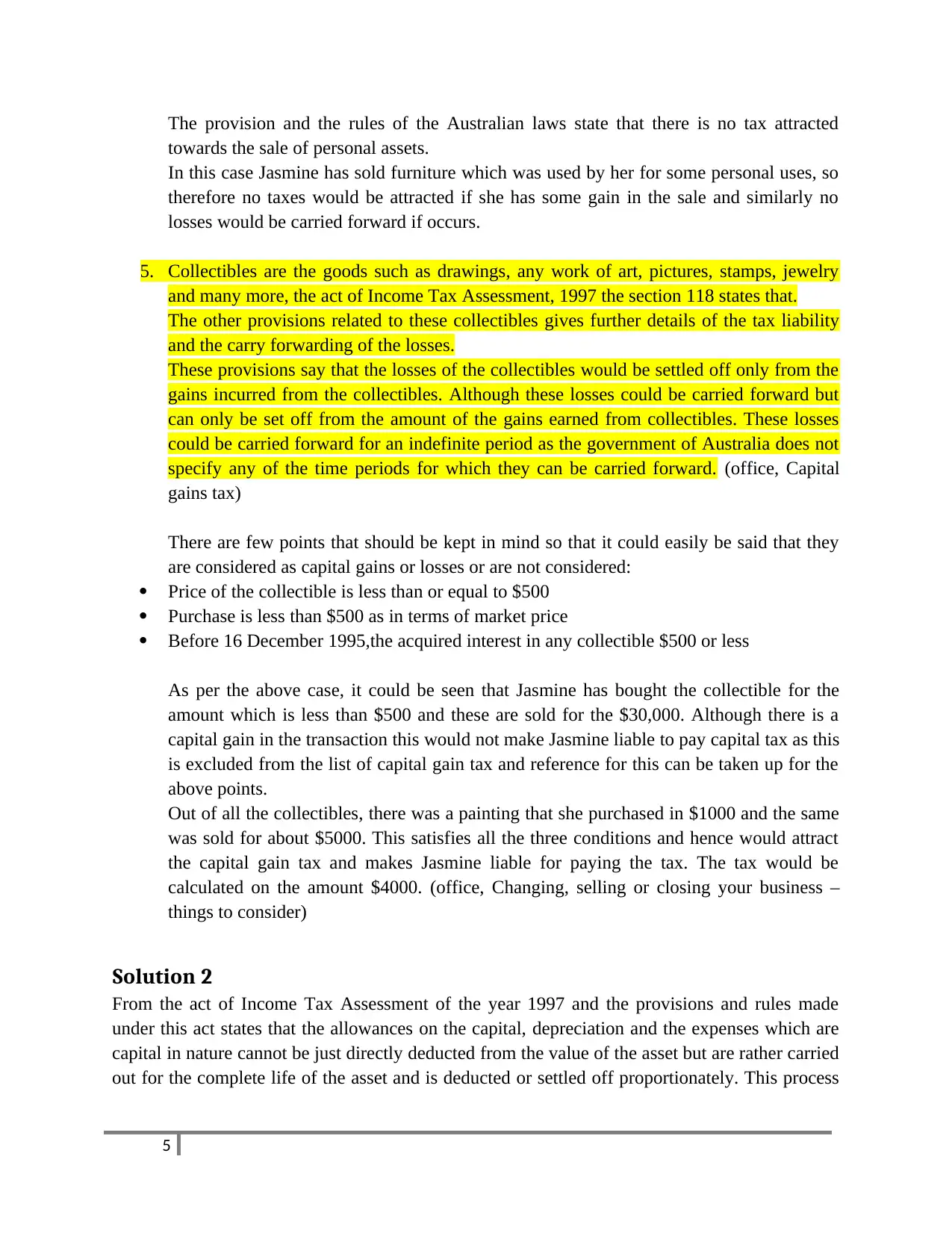
The provision and the rules of the Australian laws state that there is no tax attracted
towards the sale of personal assets.
In this case Jasmine has sold furniture which was used by her for some personal uses, so
therefore no taxes would be attracted if she has some gain in the sale and similarly no
losses would be carried forward if occurs.
5. Collectibles are the goods such as drawings, any work of art, pictures, stamps, jewelry
and many more, the act of Income Tax Assessment, 1997 the section 118 states that.
The other provisions related to these collectibles gives further details of the tax liability
and the carry forwarding of the losses.
These provisions say that the losses of the collectibles would be settled off only from the
gains incurred from the collectibles. Although these losses could be carried forward but
can only be set off from the amount of the gains earned from collectibles. These losses
could be carried forward for an indefinite period as the government of Australia does not
specify any of the time periods for which they can be carried forward. (office, Capital
gains tax)
There are few points that should be kept in mind so that it could easily be said that they
are considered as capital gains or losses or are not considered:
Price of the collectible is less than or equal to $500
Purchase is less than $500 as in terms of market price
Before 16 December 1995,the acquired interest in any collectible $500 or less
As per the above case, it could be seen that Jasmine has bought the collectible for the
amount which is less than $500 and these are sold for the $30,000. Although there is a
capital gain in the transaction this would not make Jasmine liable to pay capital tax as this
is excluded from the list of capital gain tax and reference for this can be taken up for the
above points.
Out of all the collectibles, there was a painting that she purchased in $1000 and the same
was sold for about $5000. This satisfies all the three conditions and hence would attract
the capital gain tax and makes Jasmine liable for paying the tax. The tax would be
calculated on the amount $4000. (office, Changing, selling or closing your business –
things to consider)
Solution 2
From the act of Income Tax Assessment of the year 1997 and the provisions and rules made
under this act states that the allowances on the capital, depreciation and the expenses which are
capital in nature cannot be just directly deducted from the value of the asset but are rather carried
out for the complete life of the asset and is deducted or settled off proportionately. This process
5
towards the sale of personal assets.
In this case Jasmine has sold furniture which was used by her for some personal uses, so
therefore no taxes would be attracted if she has some gain in the sale and similarly no
losses would be carried forward if occurs.
5. Collectibles are the goods such as drawings, any work of art, pictures, stamps, jewelry
and many more, the act of Income Tax Assessment, 1997 the section 118 states that.
The other provisions related to these collectibles gives further details of the tax liability
and the carry forwarding of the losses.
These provisions say that the losses of the collectibles would be settled off only from the
gains incurred from the collectibles. Although these losses could be carried forward but
can only be set off from the amount of the gains earned from collectibles. These losses
could be carried forward for an indefinite period as the government of Australia does not
specify any of the time periods for which they can be carried forward. (office, Capital
gains tax)
There are few points that should be kept in mind so that it could easily be said that they
are considered as capital gains or losses or are not considered:
Price of the collectible is less than or equal to $500
Purchase is less than $500 as in terms of market price
Before 16 December 1995,the acquired interest in any collectible $500 or less
As per the above case, it could be seen that Jasmine has bought the collectible for the
amount which is less than $500 and these are sold for the $30,000. Although there is a
capital gain in the transaction this would not make Jasmine liable to pay capital tax as this
is excluded from the list of capital gain tax and reference for this can be taken up for the
above points.
Out of all the collectibles, there was a painting that she purchased in $1000 and the same
was sold for about $5000. This satisfies all the three conditions and hence would attract
the capital gain tax and makes Jasmine liable for paying the tax. The tax would be
calculated on the amount $4000. (office, Changing, selling or closing your business –
things to consider)
Solution 2
From the act of Income Tax Assessment of the year 1997 and the provisions and rules made
under this act states that the allowances on the capital, depreciation and the expenses which are
capital in nature cannot be just directly deducted from the value of the asset but are rather carried
out for the complete life of the asset and is deducted or settled off proportionately. This process
5
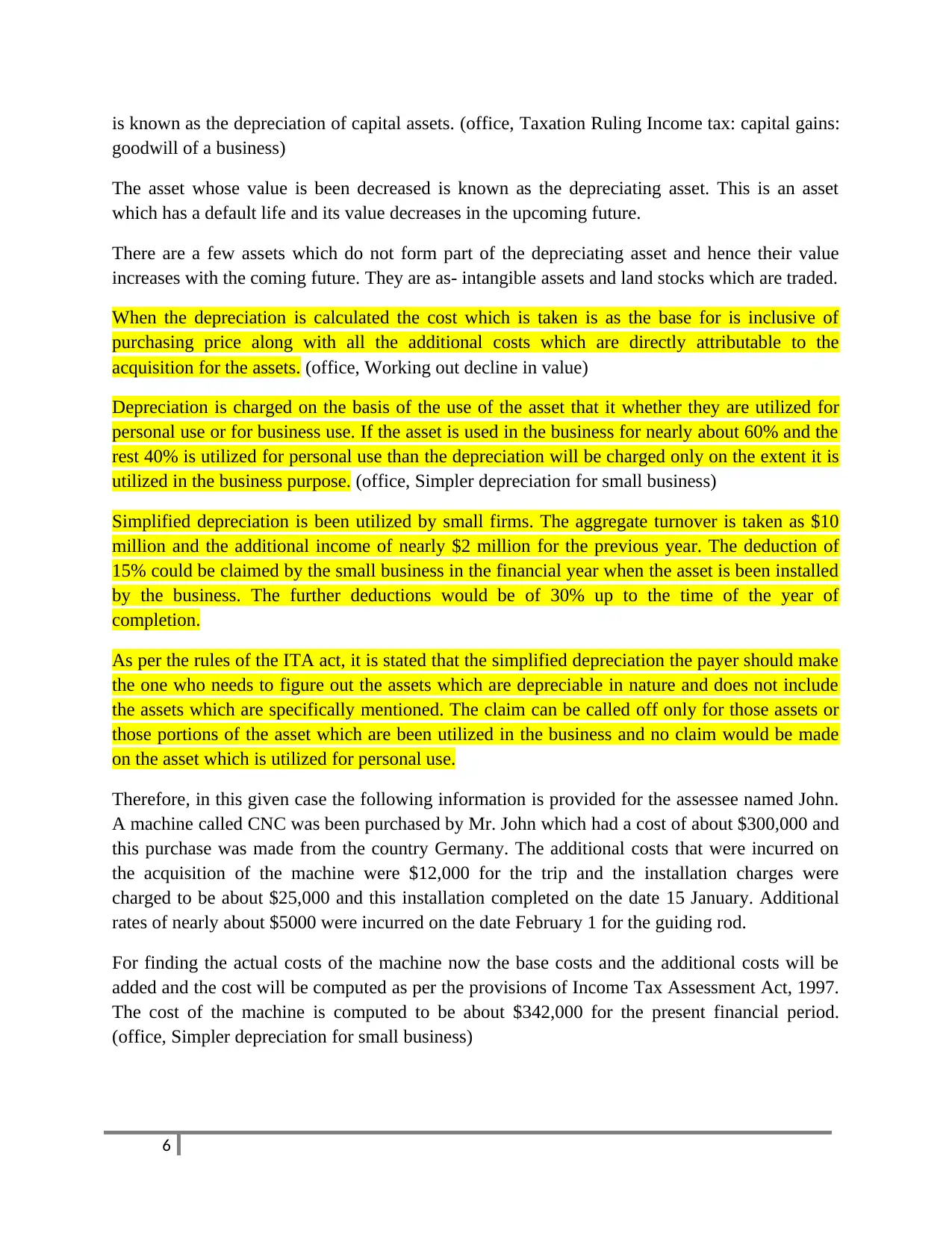
is known as the depreciation of capital assets. (office, Taxation Ruling Income tax: capital gains:
goodwill of a business)
The asset whose value is been decreased is known as the depreciating asset. This is an asset
which has a default life and its value decreases in the upcoming future.
There are a few assets which do not form part of the depreciating asset and hence their value
increases with the coming future. They are as- intangible assets and land stocks which are traded.
When the depreciation is calculated the cost which is taken is as the base for is inclusive of
purchasing price along with all the additional costs which are directly attributable to the
acquisition for the assets. (office, Working out decline in value)
Depreciation is charged on the basis of the use of the asset that it whether they are utilized for
personal use or for business use. If the asset is used in the business for nearly about 60% and the
rest 40% is utilized for personal use than the depreciation will be charged only on the extent it is
utilized in the business purpose. (office, Simpler depreciation for small business)
Simplified depreciation is been utilized by small firms. The aggregate turnover is taken as $10
million and the additional income of nearly $2 million for the previous year. The deduction of
15% could be claimed by the small business in the financial year when the asset is been installed
by the business. The further deductions would be of 30% up to the time of the year of
completion.
As per the rules of the ITA act, it is stated that the simplified depreciation the payer should make
the one who needs to figure out the assets which are depreciable in nature and does not include
the assets which are specifically mentioned. The claim can be called off only for those assets or
those portions of the asset which are been utilized in the business and no claim would be made
on the asset which is utilized for personal use.
Therefore, in this given case the following information is provided for the assessee named John.
A machine called CNC was been purchased by Mr. John which had a cost of about $300,000 and
this purchase was made from the country Germany. The additional costs that were incurred on
the acquisition of the machine were $12,000 for the trip and the installation charges were
charged to be about $25,000 and this installation completed on the date 15 January. Additional
rates of nearly about $5000 were incurred on the date February 1 for the guiding rod.
For finding the actual costs of the machine now the base costs and the additional costs will be
added and the cost will be computed as per the provisions of Income Tax Assessment Act, 1997.
The cost of the machine is computed to be about $342,000 for the present financial period.
(office, Simpler depreciation for small business)
6
goodwill of a business)
The asset whose value is been decreased is known as the depreciating asset. This is an asset
which has a default life and its value decreases in the upcoming future.
There are a few assets which do not form part of the depreciating asset and hence their value
increases with the coming future. They are as- intangible assets and land stocks which are traded.
When the depreciation is calculated the cost which is taken is as the base for is inclusive of
purchasing price along with all the additional costs which are directly attributable to the
acquisition for the assets. (office, Working out decline in value)
Depreciation is charged on the basis of the use of the asset that it whether they are utilized for
personal use or for business use. If the asset is used in the business for nearly about 60% and the
rest 40% is utilized for personal use than the depreciation will be charged only on the extent it is
utilized in the business purpose. (office, Simpler depreciation for small business)
Simplified depreciation is been utilized by small firms. The aggregate turnover is taken as $10
million and the additional income of nearly $2 million for the previous year. The deduction of
15% could be claimed by the small business in the financial year when the asset is been installed
by the business. The further deductions would be of 30% up to the time of the year of
completion.
As per the rules of the ITA act, it is stated that the simplified depreciation the payer should make
the one who needs to figure out the assets which are depreciable in nature and does not include
the assets which are specifically mentioned. The claim can be called off only for those assets or
those portions of the asset which are been utilized in the business and no claim would be made
on the asset which is utilized for personal use.
Therefore, in this given case the following information is provided for the assessee named John.
A machine called CNC was been purchased by Mr. John which had a cost of about $300,000 and
this purchase was made from the country Germany. The additional costs that were incurred on
the acquisition of the machine were $12,000 for the trip and the installation charges were
charged to be about $25,000 and this installation completed on the date 15 January. Additional
rates of nearly about $5000 were incurred on the date February 1 for the guiding rod.
For finding the actual costs of the machine now the base costs and the additional costs will be
added and the cost will be computed as per the provisions of Income Tax Assessment Act, 1997.
The cost of the machine is computed to be about $342,000 for the present financial period.
(office, Simpler depreciation for small business)
6
⊘ This is a preview!⊘
Do you want full access?
Subscribe today to unlock all pages.

Trusted by 1+ million students worldwide

The depreciation starts to be levied upon the asset from the date when it is put to use in the office
or the time when it is put to use for the first time in the office. This is the time from which the
depreciation will start from this time. (office, Depreciation and capital expenses and allowances)
Capital allowance is calculated using the following methods-
Diminishing Value Method
Prime Cost Method
These are two widely used methods through which the capital allowances are calculated.
The decline in the amount of the assets which are depreciating would only be calculated by the
methods which are mentioned in the above portion of this question.
The time of depreciation of the machine CNC will start from the date 15 January that is the date
on which the machine is completely installed in the company and was in the condition to use.
From this very time the depreciation would start levied in the company for this asset. (office,
Simpler depreciation for small business)
Conclusion
From this report it could be concluded that the ITA act of the year 1936 and the year 1997 has
made certain provisions and rules regarding the capital gain tax and the ways and methods that
how should it be levied on the assessee.
The study of these cases in the above assignment, the case of Jasmine gave the view that most of
the assets were in nature of personal use and all the assets which are for personal use does not
attract any of the capital gain tax and if losses occur then they are also not allowed to be carried
forward in the upcoming next financial years.
In the second case, John is asking for his capital allowance on the machinery he purchased. The
relevance and the provision of this are undertaken in brief and the ways are also explained for the
calculation of these allowances. (office, What is a capital gains tax asset?)
References
6 depreciation and CGT facts. (n.d.). Retrieved from http://www.apimagazine.com.au/property-
investment/6-depreciation-and-cgt-facts: http://www.apimagazine.com.au/property-investment/6-
depreciation-and-cgt-facts
A Complete Guide to Capital Gains Tax. (2019, January 2019). Retrieved from
https://propertyupdate.com.au: https://propertyupdate.com.au/a-complete-guide-to-capital-gains-tax/
Australian Capital Gains Tax (CGT). (2019). Retrieved from https://www.exfin.com:
https://www.exfin.com/australian-capital-gains
7
or the time when it is put to use for the first time in the office. This is the time from which the
depreciation will start from this time. (office, Depreciation and capital expenses and allowances)
Capital allowance is calculated using the following methods-
Diminishing Value Method
Prime Cost Method
These are two widely used methods through which the capital allowances are calculated.
The decline in the amount of the assets which are depreciating would only be calculated by the
methods which are mentioned in the above portion of this question.
The time of depreciation of the machine CNC will start from the date 15 January that is the date
on which the machine is completely installed in the company and was in the condition to use.
From this very time the depreciation would start levied in the company for this asset. (office,
Simpler depreciation for small business)
Conclusion
From this report it could be concluded that the ITA act of the year 1936 and the year 1997 has
made certain provisions and rules regarding the capital gain tax and the ways and methods that
how should it be levied on the assessee.
The study of these cases in the above assignment, the case of Jasmine gave the view that most of
the assets were in nature of personal use and all the assets which are for personal use does not
attract any of the capital gain tax and if losses occur then they are also not allowed to be carried
forward in the upcoming next financial years.
In the second case, John is asking for his capital allowance on the machinery he purchased. The
relevance and the provision of this are undertaken in brief and the ways are also explained for the
calculation of these allowances. (office, What is a capital gains tax asset?)
References
6 depreciation and CGT facts. (n.d.). Retrieved from http://www.apimagazine.com.au/property-
investment/6-depreciation-and-cgt-facts: http://www.apimagazine.com.au/property-investment/6-
depreciation-and-cgt-facts
A Complete Guide to Capital Gains Tax. (2019, January 2019). Retrieved from
https://propertyupdate.com.au: https://propertyupdate.com.au/a-complete-guide-to-capital-gains-tax/
Australian Capital Gains Tax (CGT). (2019). Retrieved from https://www.exfin.com:
https://www.exfin.com/australian-capital-gains
7
Paraphrase This Document
Need a fresh take? Get an instant paraphrase of this document with our AI Paraphraser
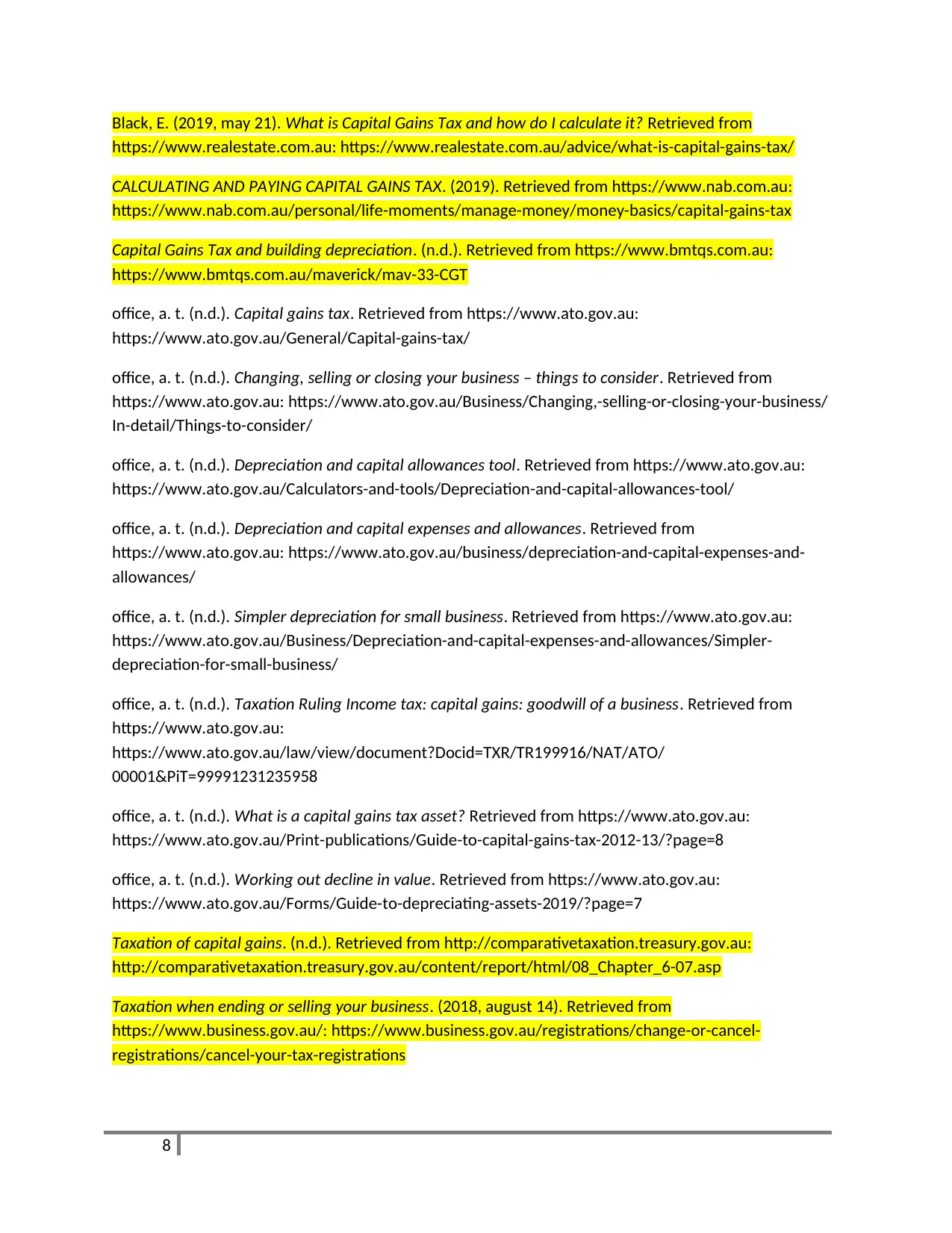
Black, E. (2019, may 21). What is Capital Gains Tax and how do I calculate it? Retrieved from
https://www.realestate.com.au: https://www.realestate.com.au/advice/what-is-capital-gains-tax/
CALCULATING AND PAYING CAPITAL GAINS TAX. (2019). Retrieved from https://www.nab.com.au:
https://www.nab.com.au/personal/life-moments/manage-money/money-basics/capital-gains-tax
Capital Gains Tax and building depreciation. (n.d.). Retrieved from https://www.bmtqs.com.au:
https://www.bmtqs.com.au/maverick/mav-33-CGT
office, a. t. (n.d.). Capital gains tax. Retrieved from https://www.ato.gov.au:
https://www.ato.gov.au/General/Capital-gains-tax/
office, a. t. (n.d.). Changing, selling or closing your business – things to consider. Retrieved from
https://www.ato.gov.au: https://www.ato.gov.au/Business/Changing,-selling-or-closing-your-business/
In-detail/Things-to-consider/
office, a. t. (n.d.). Depreciation and capital allowances tool. Retrieved from https://www.ato.gov.au:
https://www.ato.gov.au/Calculators-and-tools/Depreciation-and-capital-allowances-tool/
office, a. t. (n.d.). Depreciation and capital expenses and allowances. Retrieved from
https://www.ato.gov.au: https://www.ato.gov.au/business/depreciation-and-capital-expenses-and-
allowances/
office, a. t. (n.d.). Simpler depreciation for small business. Retrieved from https://www.ato.gov.au:
https://www.ato.gov.au/Business/Depreciation-and-capital-expenses-and-allowances/Simpler-
depreciation-for-small-business/
office, a. t. (n.d.). Taxation Ruling Income tax: capital gains: goodwill of a business. Retrieved from
https://www.ato.gov.au:
https://www.ato.gov.au/law/view/document?Docid=TXR/TR199916/NAT/ATO/
00001&PiT=99991231235958
office, a. t. (n.d.). What is a capital gains tax asset? Retrieved from https://www.ato.gov.au:
https://www.ato.gov.au/Print-publications/Guide-to-capital-gains-tax-2012-13/?page=8
office, a. t. (n.d.). Working out decline in value. Retrieved from https://www.ato.gov.au:
https://www.ato.gov.au/Forms/Guide-to-depreciating-assets-2019/?page=7
Taxation of capital gains. (n.d.). Retrieved from http://comparativetaxation.treasury.gov.au:
http://comparativetaxation.treasury.gov.au/content/report/html/08_Chapter_6-07.asp
Taxation when ending or selling your business. (2018, august 14). Retrieved from
https://www.business.gov.au/: https://www.business.gov.au/registrations/change-or-cancel-
registrations/cancel-your-tax-registrations
8
https://www.realestate.com.au: https://www.realestate.com.au/advice/what-is-capital-gains-tax/
CALCULATING AND PAYING CAPITAL GAINS TAX. (2019). Retrieved from https://www.nab.com.au:
https://www.nab.com.au/personal/life-moments/manage-money/money-basics/capital-gains-tax
Capital Gains Tax and building depreciation. (n.d.). Retrieved from https://www.bmtqs.com.au:
https://www.bmtqs.com.au/maverick/mav-33-CGT
office, a. t. (n.d.). Capital gains tax. Retrieved from https://www.ato.gov.au:
https://www.ato.gov.au/General/Capital-gains-tax/
office, a. t. (n.d.). Changing, selling or closing your business – things to consider. Retrieved from
https://www.ato.gov.au: https://www.ato.gov.au/Business/Changing,-selling-or-closing-your-business/
In-detail/Things-to-consider/
office, a. t. (n.d.). Depreciation and capital allowances tool. Retrieved from https://www.ato.gov.au:
https://www.ato.gov.au/Calculators-and-tools/Depreciation-and-capital-allowances-tool/
office, a. t. (n.d.). Depreciation and capital expenses and allowances. Retrieved from
https://www.ato.gov.au: https://www.ato.gov.au/business/depreciation-and-capital-expenses-and-
allowances/
office, a. t. (n.d.). Simpler depreciation for small business. Retrieved from https://www.ato.gov.au:
https://www.ato.gov.au/Business/Depreciation-and-capital-expenses-and-allowances/Simpler-
depreciation-for-small-business/
office, a. t. (n.d.). Taxation Ruling Income tax: capital gains: goodwill of a business. Retrieved from
https://www.ato.gov.au:
https://www.ato.gov.au/law/view/document?Docid=TXR/TR199916/NAT/ATO/
00001&PiT=99991231235958
office, a. t. (n.d.). What is a capital gains tax asset? Retrieved from https://www.ato.gov.au:
https://www.ato.gov.au/Print-publications/Guide-to-capital-gains-tax-2012-13/?page=8
office, a. t. (n.d.). Working out decline in value. Retrieved from https://www.ato.gov.au:
https://www.ato.gov.au/Forms/Guide-to-depreciating-assets-2019/?page=7
Taxation of capital gains. (n.d.). Retrieved from http://comparativetaxation.treasury.gov.au:
http://comparativetaxation.treasury.gov.au/content/report/html/08_Chapter_6-07.asp
Taxation when ending or selling your business. (2018, august 14). Retrieved from
https://www.business.gov.au/: https://www.business.gov.au/registrations/change-or-cancel-
registrations/cancel-your-tax-registrations
8

9
⊘ This is a preview!⊘
Do you want full access?
Subscribe today to unlock all pages.

Trusted by 1+ million students worldwide
1 out of 9
Related Documents
Your All-in-One AI-Powered Toolkit for Academic Success.
+13062052269
info@desklib.com
Available 24*7 on WhatsApp / Email
![[object Object]](/_next/static/media/star-bottom.7253800d.svg)
Unlock your academic potential
Copyright © 2020–2025 A2Z Services. All Rights Reserved. Developed and managed by ZUCOL.




